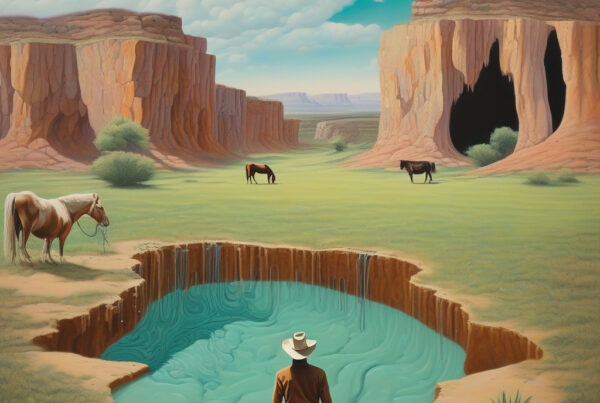As you drive north up Route 183 in Central Texas past Lampasas, you will see a sign welcoming you to Mills County: Meat Goat Capital of America.
This is no small boast. Even if Mills County claimed to be the meat goat capital of Texas, that would still be saying something. Even though the Lone Star State is rightfully regarded as cattle country, it’s also long been home to the nation’s biggest goat population.
The industry isn’t quite at the heights it reached in the mid-20th century, but recently, raising goats for meat has started to trend upwards once again in Texas.
Jake Thorne, an assistant professor and sheep and goat specialist for the Texas A&M AgriLife extension service, spoke to the Standard about the factors behind the growth. Listen to the interview above or read the transcript below.
This transcript has been edited lightly for clarity:
Texas Standard: What seem to be the main factors driving up the goat population in Texas? Just the demand is higher? And if so, where is the demand being driven?
Jake Thorne: Yeah, there is evidence that there’s an increase in demand.
Goat meat is very common in a lot of different cultures. And as we continue to get more cultural representatives from different areas of the world here in the U.S. and in Texas, they really have a desire for more goat meat in Texas – particularly kind of Central and West Texas is a big supplier of goats.
And so that’s certainly one reason. Also, goats fit a smaller ranching model very, very well.
Interesting.
Historically, the Edwards Plateau region – so Hill Country around San Angelo – has had a long history of having goats as part of the ranching model. But there’s been a lot of increase elsewhere.
Goats are really great in small acreage situations, particularly situations that have brush because goats like to browse. And, because of that increase in demand, we’ve seen increases in market prices. And a lot of people outside of just the Hill Country and Central Texas are starting to realize the benefits of raising goats.
Well, how would you compare raising goats to say, cattle? I mean, how much easier is it to raise a goat for its meat than a cow?
Yeah, it’s not necessarily easier, but they’re different.
First of all, goats are smaller. And one of the benefits, if you’re a landowner, is that they don’t require as much to eat or as much space as a cow. And so it’s much easier if you have five or 10 or 20 acres to have a little herd of goats, as opposed to 1 or 2 cows that you would have to supplement with extra feed, whereas these goats can utilize the forage that’s available on that property.
I know in Texas, once upon a time, you had plenty of huge ranches – lots of space for cows to move around. But as time goes on, I know many of those places have been sold off and subdivided into smaller lots. Is that contributing at all to the growth of the goat population here?
I believe it does. Absolutely. You’re exactly right.
The large ranching model… there are still those properties and those operations around, but not in the same numbers as they used to be. And as properties become less than 100 acres, it’s just really, really challenging to raise livestock – particularly cattle – in any kind of number at all.
And so goats, like I mentioned, fit a small acreage property very well. You can have a herd of animals that do very well on 20 acres or even less.
That’s interesting. What about the economics of being, a goat… What do you call it? Rancher, I guess. Goat farmer.
Goat rancher, yeah.
So goat prices have really surged within the last 5 to 10 years. And we’ve seen – particularly going through the pandemic and the time period after the pandemic – really, really high goat prices. For some context, around $4 a pound for a 50- to 60-pound animal that would be sold at 3 or 4 months of age. And that is really attractive to ranchers and livestock producers of all classes of livestock.
And so not only have we seen an increase in a number of small properties that have added goats, but we also have seen other ranches that produce other types of livestock add goats to their operation as an additional model, alongside cows or sheep.
Forgive me for not knowing this, but can you just buy goat meat at the local supermarket? I mean, how available is it?
That’s a very good question. Honestly, it is not nearly as available as our other types of meat. Certainly not beef, pork and chicken. It is still considered a specialty item, and you’re not necessarily going to find it at every single market. But there are some around.
Goat meat also is not always sold as a cut. In fact, a lot of the goats that are harvested in Texas and the United States are going to be sold in larger portions. So whole carcass or half carcass as opposed to like we’d think of a steak.
I see. So how is that meat generally consumed? I mean, you talk about the whole and half carcasses.
Yeah. Generally, these animals are slaughtered at a lighter weight, and these whole carcasses or half carcasses are cooked as a way to serve a meal to maybe an entire family or at a holiday gathering. And the entirety of that product that’s cooked can be consumed in that one sitting, because it’s a smaller.
You know, it’s a smaller piece of meat, but it works perfect for a group gathering – a cookout, if you may.
Do you think this trend of late has some staying power, or is this part of a cycle that’s linked to price? What’s happening in the beef, pork and chicken markets that’ll eventually, you know, take it the other direction.
It’s hard to say, but I really believe that this definitely has some staying power, because while we’re talking about the context of the rise of goat prices and interest in them within the last five years, we really have seen this trend dating back a decade or two.
And I don’t see necessarily a reverse in the land fragmentation that we talked about – smaller properties, people getting out into the country and wanting to own 5 to 10 acres. And because goats work so well in that area, we see the high prices.
We see a real demand for goat meat. We have an increasing population in the United States. All of those factors are working together to really be profitable for goat producers.















